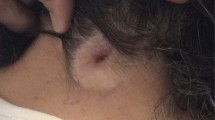Abstract
Background
Occult spinal dysraphism (OSD) encompasses various conditions. A dermal sinus tract (DST) consists of a duct communicating to the skin with deep structures that carries an important risk of infection. A different lesion consisting of a translucent skin opening and a fibrous tract that lacks a lumen can also be found in OSD. We termed this lesion pseudo-dermal sinus tract.
Patients and methods
We reviewed clinical features of 20 patients with spinal skin orifices. The patients were classified into two categories: group 1 comprised children with true DST and group 2 included patients with skin dimples resembling a DST.
Aims
The aim of this study was to analyze differential features of patients in these two groups as they behaved dissimilarly in regard to clinical significance and outcomes, especially those concerning infectious risk.
Results
Children of group 1 (n = 8) presented with tiny skin orifices and with superficial or deep infection. In contrast, group 2 (n = 12) mostly manifested with neurological symptoms. No patient in group 2 developed an infection preoperatively. In both groups, magnetic resonance showed tracts that ended in different structures. Histopathology of the lesions were dissimilar, those of group 1 being hollow tubular structures lined by epithelium while those of group 2 being solid tracts of fibrous connective tissue.
Conclusions
DST constitutes a clinicopathological diagnosis. Although sharing some common cutaneous and neuroimaging findings, both groups behaved differently. Patients of group 1 tended to show up with infection requiring urgent surgery. Patients of group 2 often presented with neurological manifestations and skin lesions, but needed no immediate operation.









Similar content being viewed by others
References
French BN (1982) The embryology of spinal dysraphism. Clin Neurosurg 30:295–340
Bale PM (1984) Sacrococcygeal developmental abnormalities and tumors in children. Perspect Pediatr Pathol 1:9–56
Lemire RJ, Beckwith JB (1982) Pathogenesis of congenital tumors and malformations of the sacrococcygeal region. Teratology 25:201–213
Wright RL (1971) Congenital dermal sinuses. Prog Neurol Surg 4:175–191
Guggisberg D, Hadj-Rabia S, Viney C, Bodemer C, Brunelle F, Zerah M, Pierre-Kahn A, de Prost Y, Hamel-Teillac D (2004) Skin markers of occult spinal dysraphism in children. A review of 54 cases. Arch Dermatol 140:1109–1015
Jankowitz BT, Albright AL (2007) Cutaneous manifestations of split cord malformation report of three cases. J Neurosurg 3 Suppl Pediatr 107:240–243
Schropp C, Sörensen N, Collmann H, Krauß J (2006) Cutaneous lesions in occult spinal dysraphism—correlation with intraspinal findings. Childs Nerv Syst 22:125–131
Elton S, Oakes WJ (2001) Dermal sinus tracts of the spine. Neurosurg Focus 10(1):e4
Ackerman LL, Menezes AH (2003) Spinal congenital dermal sinuses: a 30-year experience. Pediatrics 112:641–647
Ackerman LL, Menezes AH, Follett KA (2002) Cervical and thoracic dermal sinus tracts. Pediatr Neurosurg 37:137–147
Radmanesh F, Nejat F, El Khashab M (2010) Dermal sinus tracts of the spine. Childs Nerv Syst 26:349–357
Rapjal S, Salamat S, Tubbs RS, Kelly DR, Oakes WJ, Iskandar BJ (2007) Tethering tracts in spina bifida occulta: revisiting an established nomenclature. J Neurosurg Spine 7:315–322
Van Aalts J, Beuls EAM, Cornips EMJ, van Straaten HWM, Boselie AFM, Rijkers K, Weber JW, Vles JSH (2009) The spinal dermal-sinus-like stalk. Childs Nerv Syst 25:191–197
Perrini P, Scollato A, Guidi E, Benedetto N, Buccoliero AM, Di Lorenzo N (2005) Tethered cervical spinal cord due to a hamartomatous stalk in a young adult (case report). J Neurosurg Pediatr 2 102:244–247
James CCM, Lassman LP (1972) Spinal dysraphism. Spina bifida occulta. Butterworths, London, pp 83–97
Barkovich AJ, Edwards MSB, Cogen PH (1991) MR evaluation of spinal dermal sinus tracts in children. AJNR Am J Neuroradiol 12:123–129
Martínez-Lage JF, Esteban JA, Poza M, Casas C (1995) Congenital dermal sinus associated with an abscessed intramedullary epidermoid cyst in a child. Childs Nerv Syst 11:301–305
Martínez-Lage JF, Pérez-Espejo MA, Tortosa JG, de San R, Pedro J, Ruíz-Espejo AM (2006) Hydrocephalus in intraspinal dermoids and dermal sinuses: the spectrum of an uncommon association in children. Childs Nerv Syst 22:698–703
Powell KR, Cherry JD, Hougen TJ, Blinderman EE, Dunn MC (1975) A prospective search for congenital dermal abnormalities of the craniospinal axis. J Pediatr 87:744–750
Martínez-Lage JF, Sola J, Casas C, Poza M, Almagro MJ, Girona DG (1992) Atretic cephalocele: the tip of the iceberg. J Neurosurg 77:230–235
Tubbs RS, Murphy RL, Kelly DR, Lott R, Salter EG, Oakes WJ (2005) The filum terminale externum. J Neurosurg Spine 3:149–152
O’Rahilly R, Müller F, Meyer DB (1990) The human vertebral column at the end of the embryonic period proper. 4. The sacrococcygeal region. J Anat 168:95–111
Schenk JP, Herweh C, Günther P, Rohrschneider W, Zieger B, Tröger J (2006) Imaging of congenital anomalies and variations of the caudal spine and back in neonates and small infants. Eur J Radiol 58:3–14
Rossi A, Cama A, Piatelli G, Ravegnani M, Biancheri R, Tortori-Donati P (2004) Spinal dysraphism: MR imaging rationale. J Neuroradiol 31:2–24
Ponger P, Ben-Sira L, Beni-Adani L, Steinbok P, Constantini S (2010) International survey on the management of skin stigmata and suspected tethered cord. Childs Nerv Syst. doi:10.1007/s00381-010-1184
Disclaimer
The authors declare having no conflict of interest regarding this study and having received no funding for its production or publication
Author information
Authors and Affiliations
Corresponding author
Rights and permissions
About this article
Cite this article
Martínez-Lage, J.F., Almagro, M.J., Ferri-Ñiguez, B. et al. Spinal dermal sinus and pseudo-dermal sinus tracts: two different entities. Childs Nerv Syst 27, 609–616 (2011). https://doi.org/10.1007/s00381-010-1308-6
Received:
Accepted:
Published:
Issue Date:
DOI: https://doi.org/10.1007/s00381-010-1308-6




